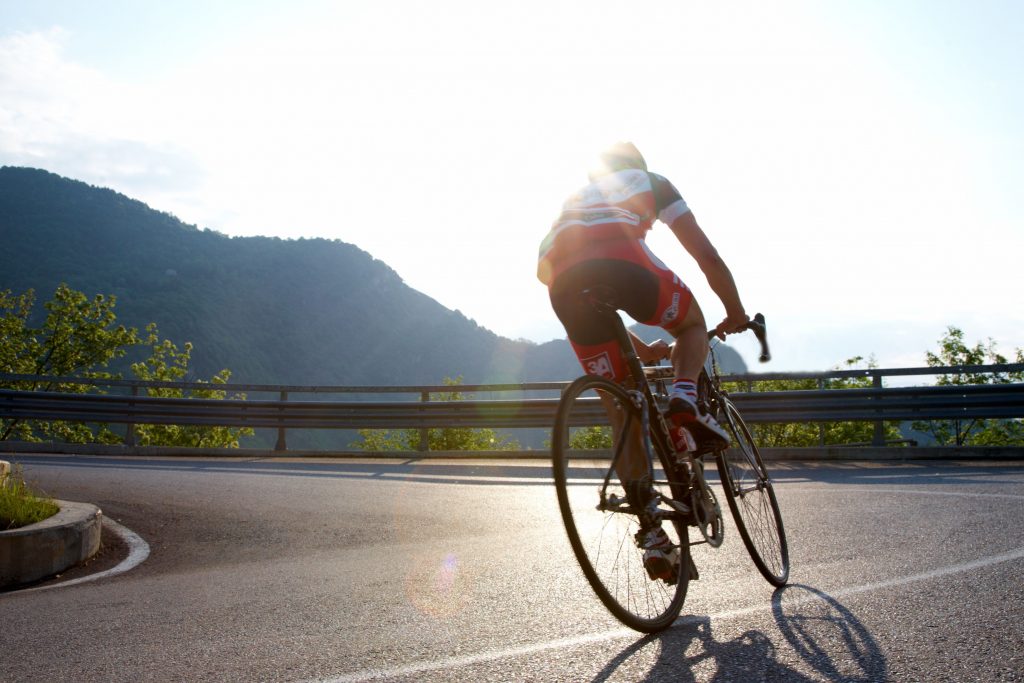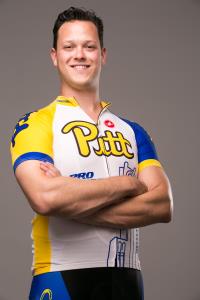I’m still playing a little catch-up on my end from a weekend of Fitness Summit shenanigans in Kansas City.
I promise I’ll have some content ready to share tomorrow into the rest of the week (you miss me, right?), but in the meantime I’ve got an excellent guest post from Israeli Strength and Conditioning coach Menachem Brodie.
Enjoy.

How the Endurance Athlete Can Appease a Shoulder That Hates Them
As a Strength & Conditioning coach who works extensively with cyclists & triathletes most folk first reaction is “WTF Mate?” or “I didn’t even know that was a thing!”
When asked to describe it to people, the best I can come up with is that I know pretty much EXACTLY how Scott Evil feels:

Not “Strength coach” enough for that crowd, and not quite “Cycling enough” for that crowd…
But there is a ton that we can learn about posture and shoulder health from our two wheeled, pedal pushing friends, as they spend hours in positions just a bit more extreme than you or I sitting on the couch watching TV on the weekends.
The difference is that while we ingest 2,000 calories in Buffalo Wild Wings and that awesome ranch dressing, they burn those calories climbing mountains.
While posture and shoulder health have a huge impact on our overall well-being and can have significant and far-reaching effects, those effects are not always felt before it’s too late in the game.
This is especially true for Road Cyclists, runners, and triathletes, as their sport, by design, requires the body to work for long periods of time, preferably as energy efficiently as possible.
When I first started coaching cyclists for performance & strength, I focused on the glutes and their huge impact on the pelvis, spine, and rib cage as they supply the base of power on the bike and support for the upper body.
But it quickly became apparent that while I was on the right track, there was something even more basic that limits cyclists performance: Their posture….It is completely jacked due to hours on the bike in a closed position, supporting around 30% their weight with their hands and arms. (If you’re a cyclist and feel that you’re subjectively supporting more than 30% of your weight with your arms, go see a bike fitter, after you get started with the exercises we learn today.)

And so, the journey down the rabbit hole began, except unlike Alice, I could answer the Cheshire Cat with a definitive answer to “Where do you want to go?”
- Improved performance
- Improved quality of life
- Avoiding looking like a Time trial cyclist/ the hunchback of Notre Dame….when you’re walking around at age 60
Let’s Get Down to Basics
There are two diaphragms in the torso that we want to have aligned in order to allow our body to function properly, including managing internal pressure, allow for proper/optimal muscle function, improved breathing, improved rib mobility, and much, much more:
Thoracic Diaphragm – controls pressure between chest and abdomen, the muscle responsible for respiration in the body, and what most people think of then you mention “Your diaphragm”.
Pelvic Floor – Controls pressure between pelvis and abdomen.
Interestingly enough, while in the general population we may see issues mostly at two of these diaphragms (Pelvic Floor and Thoracic diaphragms), in cyclists we tend to see a bit more issues, in large part due to the extreme position in which these athletes must perform for their sport.
Add into this mix that cycling is pretty much the only sport we have where the feet rotate about a fixed axis, variability in terrain, road surface, winds, and rider movements on the bike, and we have the right ingredients for some major movement issues.
Bear in mind that EVERY sport develops/requires its fair share of movement “deficiencies” or “imbalances at joints” due to repetitive tasks and movements, and while this is a part of sport, we need to keep our “average” cyclist in balance – after all, they are competitive in cycling, but a pro at something else…
Cycling puts you into an extremely vulnerable spot posture wise, not to mention with drivers (of note, PLEASE give us three feet when passing, it’s F***ing scary to have a car whiz past you within inches of knocking you off the road… when they could have waited 5 more seconds and given space… not to mention it’s pretty much law in nearly all countries and states).

Unfortunately, many in the cycling and triathlon communities have come to simply accept some forms of injuries as a right of passage for cyclists who are out there riding hard year in and year out.
From frozen shoulders and lower back pain, to constant upper neck pain and loss of hip extension….and a number of other issues, the communities have come to determine that “it just happens due to playing our sport”.
But it doesn’t have to be that way.
If we simply work on a few basic moves off the bike, we can have a significant positive impact on the riders performance and health, as well as YOUR performance and health from constantly flexing your spine to scroll through Instagram and Facebook throughout the day.
(Yeah, I saw you sit up a little straighter right there).
Opening the shoulder girdle, re-attaining proper scapular rhythm, and attaining better alignment of the Cervical, Thoracic, and Pelvic diaphragms are the goals we strive for and are not won in a few weeks, but rather over the course of a few months, and for more veteran riders, years.
It takes consistent work, done over a time period to see major gains and advances.
While it’s tough to argue which of these three diaphragms is “The most important to address” as it is based off of each individual athlete and what/if any issues they are having, we can say that due to our modern-day lifestyle, the shoulder girdle is a great place to start, as most cyclists will move to a compromised position at some point in longer/harder rides.
Not to mention that keeping the shoulder in good balance can relieve pressure on the brachial plexus, reduce the risk/ development of an overgrown coracoid process, as well as help alleviate some of the tension from the cervical extensors that are working so hard.
This allows accessory muscles of the thorax and neck to work as…. Accessory muscles, not stabilizers hanging on for dear life. As we get the shoulder joint sitting better, we can see the rib cage begin to gain proper movement, which leads to a better alignment of the Pelvic and Thoracic diaphragm, which allows the pelvic floor to relax and glutes and pelvic floor to activate in order to stabilize and move the body with more efficiency.
If we know that joint position dictates muscle function, then there are so many compensations happening in the sport of cycling, that many muscles wind up feeling like Tom Hanks in Castaway: They know what it’s like to be social and around others, but they begin to become detached from reality, and start doing other funny things.
Aside from helping to put you in the best position to maximize energy expenditure, keeping the shoulders healthy and moving well can help you be able to EAT while out on the bike as well!
The number of riders I’ve had the last ten years who had lost proper range of motion in their dominant shoulder, and were unable to eat on the bike due to loss of the range of motion thus not being able to reach into their back pockets, and “not trusting” their other hand to steer, is many.
While we often see hip issues in cyclists as well, we know that the hip and opposite shoulder work together in unison to allow us to move forward, and thus why starting at the shoulder along with breathing, can significantly improve a riders performance AND their quality of life.
Enough of the talk, let’s get into some solid action items that you can implement 3-5 days a week, in 15 minutes or less, to help you get back to great posture and able to express your true conditioning and strength, no matter what your sport.
Before jumping into the exercises, be sure to take 4-6 minutes to foam roll/ lax ball, especially:
Foam rolling the Lats
Foam rolling the chest
LAX ball/ ACUMobility the neck – all the cool kids are talking about the ACUMobility ball, and while I haven’t used it myself, it does look like a useful piece of equipment that will be regularly used, so yes, I’ll jump on the bandwagon.
Just don’t make the mistake that many endurance athletes do and spend too much time on the roller/lax ball. If you’re doing soft tissue mobility for longer than 10-12 minutes, you need to get a life/ take a hard look at your recovery/ lack of recovery between sessions.
It’s not how hard you can go in a session, it’s going hard enough that you can recover session to session, while keeping consistency in your trainings.
After the foam roller we’ll jump into breathing as shoulder joint position will also affect inhalation and exhalation, so we’re going to start here, with learning to breathe.
Learning to Breathe & Resetting the Diaphragm
All 4’s Quadruped Breathing – Resetting the Diaphragm
1 set of 5 deep breaths through the nose, out through the mouth. Hold each breath for 4 seconds
Crocodile Breathing – Filling the Cavity Evenly
1 set of 5 to 8 breaths
Next, we want to work on opening the shoulder, but in a way that allows us to tap into Thoracic Rotation. For some of you this may be a bit much, be sure to listen to your body, and breathe out and RELAX when you hit a tough spot.
Side Lying Windmill
Opening up lats, pecs, and T-spine to help the athlete function better.
One set of 8 each side
Finally, we work to fire up some muscles that may have been turned off, and/or “went on break.”
Wall Scap Slides
– Activating the Serratus anterior, Mid and lower Traps.
1 set of 8- make sure to keep your ribs from flaring, and your chin tucked.
Behind the Back Band Pull Aparts
– Activating the lower traps and rhomboids.
1 set of 8
Chin Nod, Progressing to Chin tuck Head lift
Helping activate the deep core, and fire up the muscles in your neck.
1 set of 8
Wrap Up
While these seem like a lot, you can and should be able to execute these exercises, in this order, 3-5 days a week, in 10-15 minutes. Remember, it’s not doing the exercises intensely or until fatigue that will help you see progress, it’s the CONSISTENCY that will.
About the Author

Menachem Brodie is a USA Cycling Certified Expert Level Coach, NSCA Certified Strength & Conditioning Specialist, Postpartum Corrective Exercise Specialist, and Serotta Certified Bike Fitter with over 20 years in the Health & Fitness Industry. “Brodie” as he is known, has done over 15 presentations for USA Cycling on Strength Training for Cycling, and is the author of Training Peaks Universities “Strength Training for Cycling Success” Online course.
When he’s not geeking out reading Ex-phys books, riding his bike, or trying to lift heavy things, he’s probably sleeping….errr, “recovering”. If you see Brodie without a coffee in his hand, something is probably amiss and you should call 911 immediately, as he may be signaling you for help.



